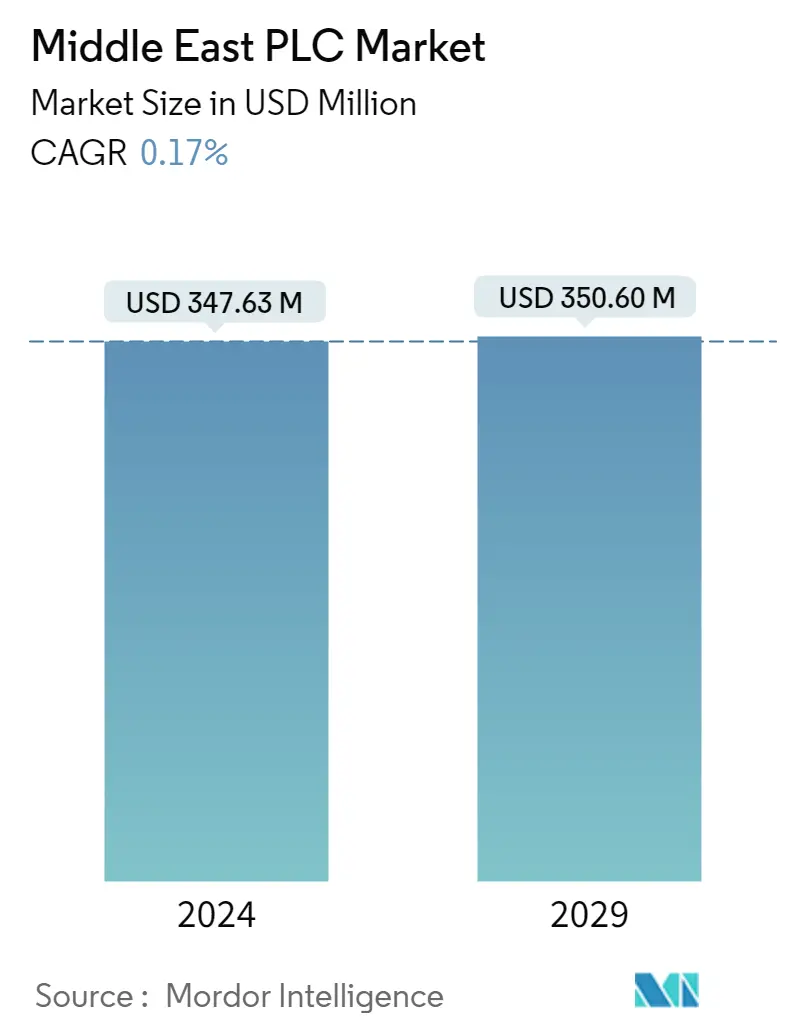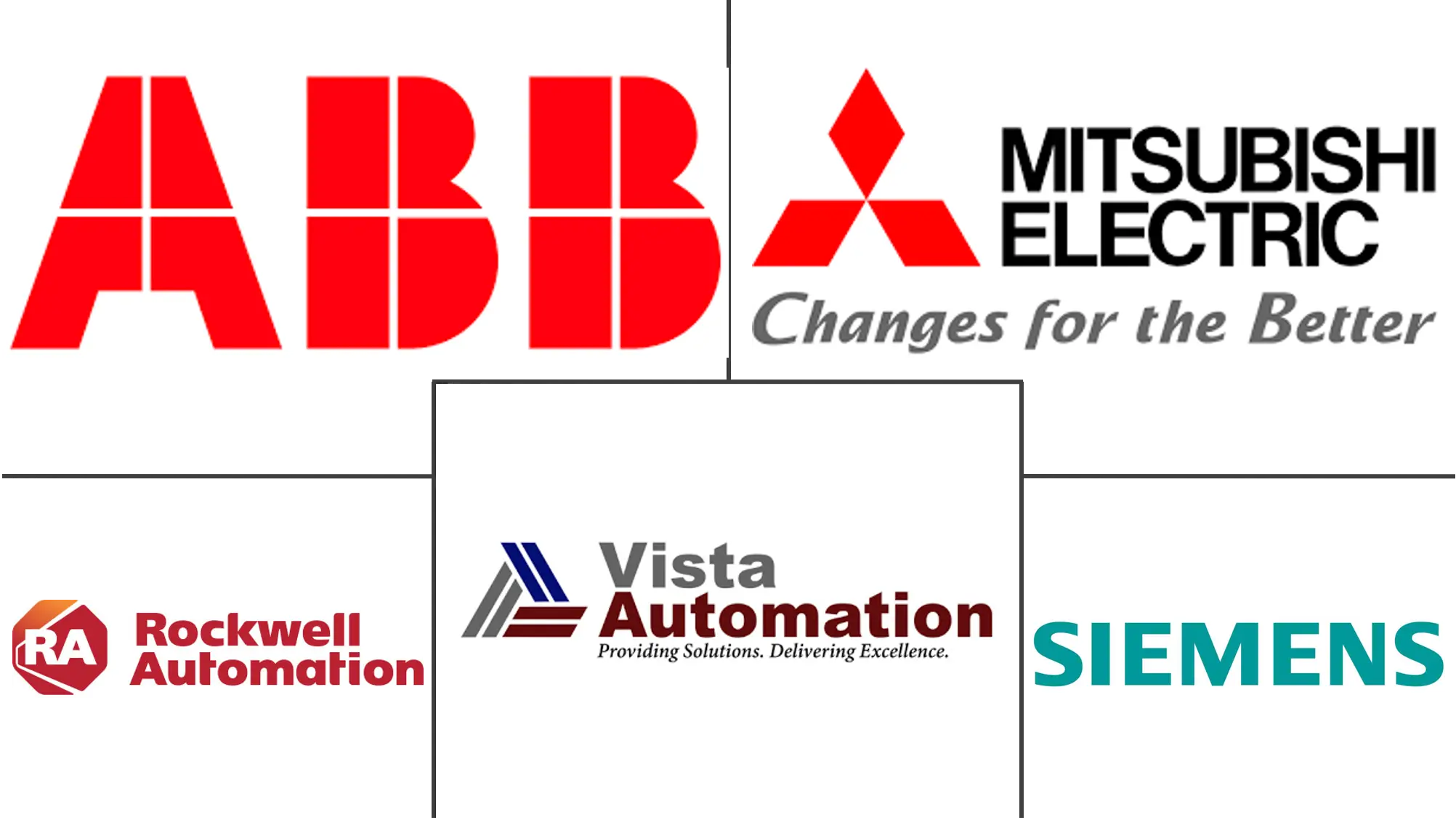Market Size of Middle East PLC Industry

| Study Period | 2019 - 2029 |
| Base Year For Estimation | 2023 |
| Market Size (2024) | USD 347.63 Million |
| Market Size (2029) | USD 350.60 Million |
| CAGR (2024 - 2029) | 0.17 % |
| Market Concentration | Medium |
Major Players
*Disclaimer: Major Players sorted in no particular order |
Middle-East Programmable Logic Controller (PLC) Market Analysis
The Middle East PLC Market size is estimated at USD 347.63 million in 2024, and is expected to reach USD 350.60 million by 2029, growing at a CAGR of 0.17% during the forecast period (2024-2029).
The deployment of PLC systems helps identify and rectify errors and can initiate rapid responses without human intervention. Hence, these automated PLC systems can considerably reduce machine downtime. Moreover, a significant rise in industrial automation and IT infrastructure in Israel paves the way for development in the PLC market.
The growth of the oil and gas sector in the region is driving the PLC market. As per the U.S. Energy Information Administration (EIA), the Middle East includes five of the top ten oil-producing countries and is responsible for a significant share of the total oil production in the world. As per EIA, Saudi Arabia alone produces about 11 million barrels of oil per day which is nearly 11% of world output. With such high production, producers are now seeking a better solution, such as a programmable logic controller (PLC), to help them be more efficient and reduce costs. These controllers are modular, scalable, and capable of handling various communications and application support.
Increasing usage of automation systems in different end-user verticals, such as manufacturing and transportation & warehousing, construction, and utilities, is driving the market. PLC is a ruggedized computer used for industrial automation and can automate a specific process, machine function, or even an entire production line. It receives information through connected sensors or input devices, processes the data, and triggers outputs based on pre-programmed parameters.
Moreover, countries such as the United Arab Emirates are installing smart girds in cities like Dubai, which is expected to further expand the demand for PLCs. For instance, in April 2022, the Dubai Electricity and Water Authority launched the next phase of its USD 1.9 billion smart grid strategy, covering the years 2021 to 2035.
With the onset of the COVID-19 pandemic, significant industries in the Middle East, including energy, food & beverage, and oil sectors, among others, were impacted. Oil production and export are major sources of economic stabilization in the Middle East region. The oil exporters of the Middle East countries faced the additional shock of plummeting oil prices due to travel restrictions following the public health crisis. However, with the pandemic-related restrictions easing up, the market is expected to witness renewed growth in the coming years.
However, low manufacturing activities of electronic components in the region have resulted in slow adoption of the devices, which restricts the market's growth.
Middle-East Programmable Logic Controller (PLC) Industry Segmentation
PLC is the primary computing system that helps control automated machines. The system also helps detect any errors or flaws and alerts the technician. Another advantage of PLCs is their multi-functionality, which are functionally used in applications such as automotive, oil & gas, etc., in the Middle-East.
| By Type | |
| Hardware | |
| Software | |
| Services |
| By End-User Industry | |
| Food, Tobacco, and Beverage | |
| Automotive | |
| Chemical and Petrochemical | |
| Energy and Utilities | |
| Pharmaceutical | |
| Oil and Gas | |
| Other End-user Industries |
| By Country | |
| United Arab Emirates | |
| Saudi Arabia | |
| Israel | |
| Oman | |
| Rest of Middle-East |
Middle East PLC Market Size Summary
The Middle East Micro Programmable Logic Controller (PLC) market is poised for modest growth over the forecast period, driven by the increasing adoption of industrial automation across various sectors. The region's robust oil and gas industry, a significant contributor to its economy, is a primary driver of this market expansion. As one of the world's leading oil-producing regions, countries like Saudi Arabia and the United Arab Emirates are leveraging PLC systems to enhance operational efficiency and reduce costs in their extensive oil and gas operations. The deployment of PLCs in these industries is crucial for automating processes, improving safety, and ensuring the stability of pipeline transmissions. Additionally, the rise in smart grid installations, particularly in urban centers like Dubai, is expected to further boost the demand for PLCs, as these systems play a vital role in managing and distributing renewable energy sources.
Despite the promising growth prospects, the Middle East PLC market faces challenges, such as the slow adoption of electronic components due to limited manufacturing activities in the region. However, the market is supported by significant investments from both government and private sectors in energy and utilities, which have facilitated the penetration of automation technologies. Major players in the market, including Vista Automation, Honeywell, and Rockwell Automation, are actively expanding their presence and offerings to capture a larger share of the market. The integration of PLCs in smart meters and solar tracking systems highlights the region's commitment to enhancing energy efficiency and reducing carbon emissions. As the Middle East continues to invest in upgrading its infrastructure and embracing renewable energy, the PLC market is expected to witness steady growth, driven by technological advancements and strategic partnerships.
Middle East PLC Market Size - Table of Contents
-
1. MARKET INSIGHTS
-
1.1 Market Overview
-
1.2 Industry Attractiveness - Porter's Five. Forces Analysis
-
1.2.1 Bargaining Power of Suppliers
-
1.2.2 Bargaining Power of Consumers
-
1.2.3 Threat of New Entrants
-
1.2.4 Intensity of Competitive Rivalry
-
1.2.5 Threat of Substitutes
-
-
1.3 Industry Value Chain Analysis
-
1.4 Impact of COVID-19 Outbreak on the Industry
-
-
2. MARKET SEGMENTATION
-
2.1 By Type
-
2.1.1 Hardware
-
2.1.2 Software
-
2.1.3 Services
-
-
2.2 By End-User Industry
-
2.2.1 Food, Tobacco, and Beverage
-
2.2.2 Automotive
-
2.2.3 Chemical and Petrochemical
-
2.2.4 Energy and Utilities
-
2.2.5 Pharmaceutical
-
2.2.6 Oil and Gas
-
2.2.7 Other End-user Industries
-
-
2.3 By Country
-
2.3.1 United Arab Emirates
-
2.3.2 Saudi Arabia
-
2.3.3 Israel
-
2.3.4 Oman
-
2.3.5 Rest of Middle-East
-
-
Middle East PLC Market Size FAQs
How big is the Middle East PLC Market?
The Middle East PLC Market size is expected to reach USD 347.63 million in 2024 and grow at a CAGR of 0.17% to reach USD 350.60 million by 2029.
What is the current Middle East PLC Market size?
In 2024, the Middle East PLC Market size is expected to reach USD 347.63 million.

